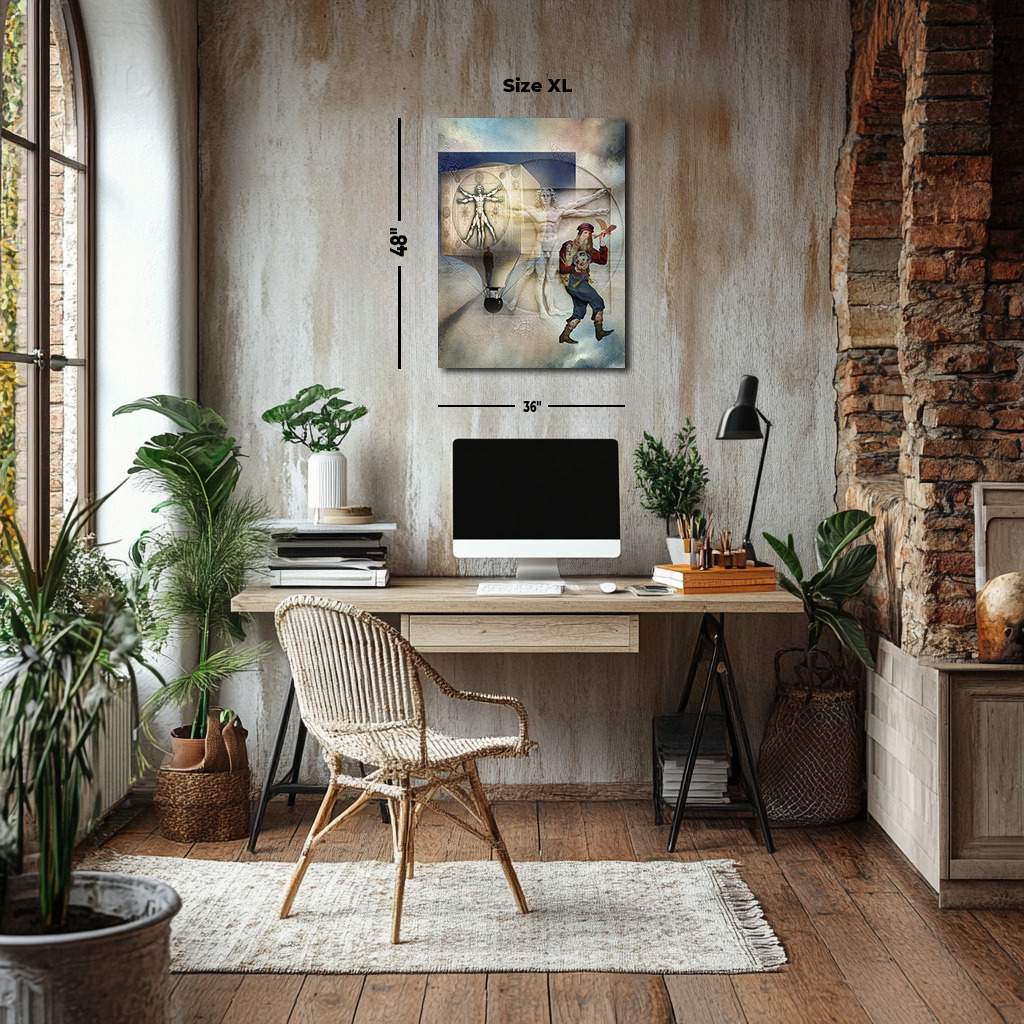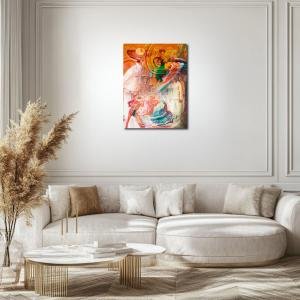Boundaries of Human Innovation: Vitruvian Man and the Dream of Flight
"Boundaries of Human Innovation: Vitruvian Man and the Dream of Flight" reimagines Leonardo’s Vitruvian Man as a symbol of human potential and progress. The central figure remains true to Leonardo’s original vision but is placed within the surreal context of a balloon, representing humanity's ambition to transcend earthly limits. The use of warm and cool colors evokes the tension between earthly grounding and celestial freedom. The surreal combination of a historical figure with a bird suggests the freedom of the imagination and the connection between invention and nature. This reinterpretation speaks to the timeless nature of human curiosity, reminding us of the continuous evolution of thought and possibility.
Please see Below for Details…
Hotline Order:
Mon - Fri: 07AM - 06PM
404-872-4663
Leonardo da Vinci’s Vitruvian Man, created around 1490, is one of the most iconic images in the history of art and science. A perfect synthesis of the human body and geometry, it represents the ideal proportions of man, based on the ancient Roman architect Vitruvius’s principles. In this reinterpretation, the Vitruvian Man becomes a gateway to exploration, movement, and the expansion of human potential. The image of the human body is not merely a static symbol of symmetry but a dynamic interaction with the forces of nature, technology, and imagination.
The central figure of the Vitruvian Man remains intact in this surreal collage, poised within the confines of a square and a circle, symbolizing the intersection of the physical and the metaphysical. The figure’s limbs extend outward, embodying the harmony of form and function as conceptualized by Vitruvius. However, as we move into the surreal realm, this iconic shape is juxtaposed with elements that transcend its original intention, pushing the boundaries of human potential.
To the left, the Vitruvian Man seems to soar within the framework of a balloon, representing the human desire for flight and transcendence. The hot air balloon symbolizes human ingenuity and the attempt to break free from the constraints of gravity. The floating figure inside the balloon evokes the dream of flight that Leonardo himself explored with sketches of flying machines and mechanisms. This symbolic layering of the past with the future is a powerful statement of how the pursuit of knowledge is an unending quest for advancement, going beyond theoretical designs and into the realms of practical realization.
Behind the central figure is a man, drawn in a historical costume, and holding a compass with a bird perched on his finger. This figure, while reminiscent of Leonardo’s own self-portraits, represents the continual evolution of knowledge from the classical to the modern. The compass is not only a tool for measurement but a metaphor for the precision and intellectual structure that guides human invention. The bird on his finger introduces an element of freedom and possibility, tying back to the idea of flight and the connection between human aspiration and nature’s forces.
In this composition, the colors and tones play a crucial role in the emotional depth and intellectual resonance of the piece. The muted golden tones of the Vitruvian Man contrast with the cool, faded blues and purples in the background, symbolizing the grounding of humanity in the earthly realm while reaching for the unknown. The warm tones of the balloon’s airlift contrast with the soft grays of the figure’s body, implying the continual tension between the material and the spiritual. The bright colors surrounding the human form suggest not only innovation but the vibrancy of life that emerges when humanity reaches beyond itself.
The atmospheric background, with faint clouds and abstract elements that seem to dissolve into the landscape, reflects the openness of space and the endless possibilities for human exploration. The surreal aspect comes alive as the boundaries between human form, nature, and invention blur. The gentle gradient of light pushing from the figure's center suggests an inner energy, a force that drives forward-thinking, curiosity, and the breaking of boundaries. It also alludes to the transcendence of the mind—the ability to dream beyond the visible world and create new horizons.
As an artist, my intention in reimagining Leonardo’s Vitruvian Man was to recontextualize it as a symbol of progress, not confined to the realm of static proportions, but extended into the vast canvas of possibility that Leonardo himself might have imagined in his own explorations. I wanted to emphasize the fluidity of human potential, where the geometrical precision of the human body becomes a gateway to transcendence. I chose to include elements of flight and invention to mirror Leonardo’s own work, which crossed disciplines—art, science, anatomy, and engineering. The image of the balloon, along with the subtle integration of technology and nature, signifies the harmony of human ambition and the natural world.
The deep emotional message embedded in this art is the timeless nature of human curiosity. It speaks to the idea that human potential is not fixed but constantly evolving. The Vitruvian Man, initially a study in proportion, has transcended its original purpose, becoming a universal symbol for human possibility. By incorporating elements like flight and invention, I have sought to explore how human beings, equipped with knowledge and creativity, can stretch the boundaries of what is possible and continue to aspire beyond their limitations.
This work also reflects the duality of progress: while technology enables us to reach new heights, it is our understanding of ourselves and our place in nature that must guide this journey. As we look to the future, the past is never forgotten, and the harmony of the human form continues to remind us of our innate potential.
Add your review
Your email address will not be published. Required fields are marked *
Please login to write review!
Looks like there are no reviews yet.










